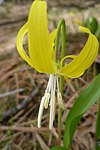bio.wikisort.org - Plant
Erythronium grandiflorum is a North American species of plants in the lily family.[1] It is known by several common names, including yellow avalanche lily, glacier lily, and dogtooth fawn lily.[2][3] The Ktunaxa name for glacier lily is maxa.[4]
| Erythronium grandiflorum | |
|---|---|
 | |
| Erythronium grandiflorum Mount Rainier National Park | |
| Scientific classification | |
| Kingdom: | Plantae |
| Clade: | Tracheophytes |
| Clade: | Angiosperms |
| Clade: | Monocots |
| Order: | Liliales |
| Family: | Liliaceae |
| Subfamily: | Lilioideae |
| Tribe: | Lilieae |
| Genus: | Erythronium |
| Species: | E. grandiflorum |
| Binomial name | |
| Erythronium grandiflorum | |
| Synonyms[1] | |
|
Synonymy
| |
Description
Erythronium grandiflorum grows from a deep bulb (or corm) which is 3 to 5 centimeters wide. Its two green leaves are wavy-edged and up to 20 centimeters long. The stalk may reach 30 centimeters tall and bears one to three showy flowers. Each flower has bright lemon yellow petals, white stamens with large white to yellow to red anthers, and a white style.[5]
The Flora of North America recognizes two subspecies, the yellow-flowered subsp. grandiflorum and the white- to cream-flowered subsp. candidum.[6] More recent publications consider subsp. candidum to be a distinct species, called Erythronium idahoense.[1]
Distribution and habitat
It is native to western North America from British Columbia and Alberta south to New Mexico and California, though it has not been reported from Arizona or Nevada.[7] It can be found in subalpine mountain meadows, slopes, and clearings.[1][8]
Ecology
The flower is pollinated by bumblebees and other bees. The bulbs are an important and preferred food of the grizzly bear. Mule deer readily eat the foliage.[9][10][11]
Uses
The bulbs can be eaten cooked, or raw to avoid starvation[12] (though they can cause nausea this way).[13] The leaves and flowers are also edible raw or cooked.[14]
Gallery
- Bud and flower
- Blooms in Missoula, Montana
- Young fruit
References
- Kew World Checklist of Selected Plant Families
- Jepson Manual Treatment
- United States Department of Agriculture Plants Profile
- "FirstVoices- Ktunaxa. Plants: food plants: words". Retrieved 2012-07-07.
- "Yellow Avalanche Lily, Erythronium grandiflorum". calscape.org.
{{cite web}}: CS1 maint: url-status (link) - Flora of North America 26 Page 156, Glacier-lily, Erythronium grandiflorum Pursh, Fl. Amer. Sept. 1: 231. 1814
- Biota of North America Program 2014 county distribution map
- Clennett, C. (2014). The genus Erythronium: 1-158. Kew Publishing, Kew.
- Pursh, Frederick Traugott. 1814. Flora Americae Septentrionalis 1: 231
- Hitchcock, C. H., A.J. Cronquist, F. M. Ownbey & J. W. Thompson. 1969. Vascular Cryptogams, Gymnosperms, and Monocotyledons. 1: 1–914. In C. L. Hitchcock Vascular Plants of the Pacific Northwest. University of Washington Press, Seattle.
- Applegate, Elmer Ivan. 1933.
- Reiner, Ralph E. (1969). Introducing the Flowering Beauty of Glacier National Park and the Majestic High Rockies. Glacier Park, Inc. p. 36.
- Benoliel, Doug (2011). Northwest Foraging: The Classic Guide to Edible Plants of the Pacific Northwest (Rev. and updated ed.). Seattle, WA: Skipstone. p. 91. ISBN 978-1-59485-366-1. OCLC 668195076.
- Nyerges, Christopher (2017). Foraging Washington: Finding, Identifying, and Preparing Edible Wild Foods. Guilford, CT: Falcon Guides. ISBN 978-1-4930-2534-3. OCLC 965922681.
External links
- United States Department of Agriculture, National Forest Service, Index of Species Information
- Calphotos Photo gallery
- Northern Bushcraft
На других языках
- [en] Erythronium grandiflorum
[es] Erythronium grandiflorum
Erythronium grandiflorum es una especie de planta bulbosa perteneciente a la familia de las liliáceas la cual es conocida con los diferentes nombres comunes de yellow avalanche lily, glacier lily, y dogtooth fawn lily. Es originaria del oeste de Norteamérica desde California a Alberta o Nuevo México. Se puede encontrar en los prados subalpinos de montaña, en pendientes, y en los claros.Другой контент может иметь иную лицензию. Перед использованием материалов сайта WikiSort.org внимательно изучите правила лицензирования конкретных элементов наполнения сайта.
WikiSort.org - проект по пересортировке и дополнению контента Википедии





